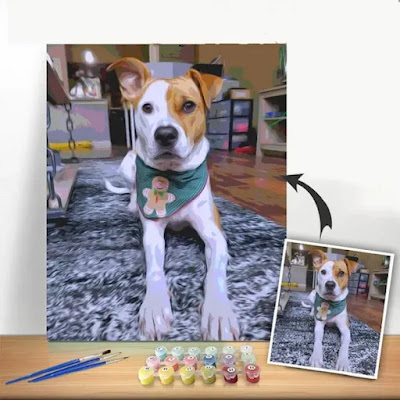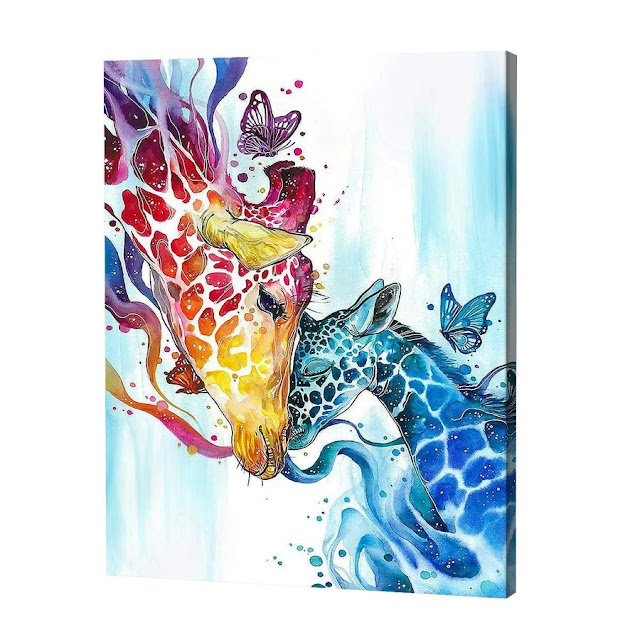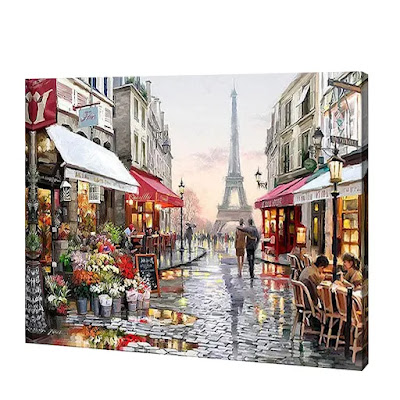Common Problems in Paint by Number and How to Solve Them
Paint by number pictures have grown in popularity as
a fun and relaxing way to create beautiful art. However, despite their
simplicity, many artists encounter common problems that can affect the quality
of their finished pieces. Whether you’re a beginner or an experienced enthusiast,
understanding these issues and knowing how to resolve them can help you achieve
stunning results. This guide will walk you through the most common problems in paint by number projects and provide
practical solutions.
1. Paint Dries Too Quickly
One of the most common problems when working with paint
by number pictures is that the acrylic paint dries too quickly. This
can make blending difficult and lead to a patchy finish.
Solution: To keep your paints from drying out, only
dispense small amounts of paint at a time and keep the lids on tightly when not
in use. You can also add a few drops of water to the paint to keep it moist. If
you need more time to blend, consider using a paint retarder or slow-drying
medium, which can extend the drying time and give you more flexibility.
2. Brush Strokes Are Visible
Visible brush strokes can make paint by number pictures
look unrefined and amateurish, detracting from the overall appearance of the
painting.
Solution: To minimize visible brush strokes, use
smooth, even strokes and avoid overworking the paint. Applying multiple thin
layers instead of one thick coat can help achieve a smoother finish. Use
high-quality brushes that are appropriate for the paint’s viscosity, and try
lightly sanding the dried layers between coats with fine-grit sandpaper to
create an even surface.
3. Paint Goes Outside the Lines
It’s easy to accidentally paint outside the lines,
especially in areas with small or intricate sections, which can make your
painting look messy.
Solution: Use a fine-tipped brush for detail work,
and keep a damp cloth or cotton swab handy to quickly wipe away any mistakes
before the paint dries. You can also use a white gel pen or a fine brush dipped
in the background color to touch up and cover any stray marks. If precision is
a constant issue, consider investing in a magnifying glass or a clip-on lamp to
see the tiny sections more clearly.
4. Uneven Color Coverage
Uneven color coverage, such as streaks or patchy areas, is a
common issue in paint by number pictures, especially when using lighter
colors that may not provide full coverage on the first application.
Solution: Applying multiple thin coats is the best
way to ensure even color coverage. Allow each layer to dry completely before
adding the next to prevent lifting the paint underneath. If the paint appears
too transparent, you can mix in a tiny amount of white paint to make it more
opaque. Stir your paint thoroughly before applying to ensure the pigments are
evenly distributed.
5. Colors Don't Match the Reference Image
Sometimes the colors in the kit may not perfectly match the
reference image, leading to a finished piece that looks different from what you
expected.
Solution: If the color doesn’t match, consider mixing
your own shades to get closer to the desired look. You can adjust the hue by
adding small amounts of complementary colors until you achieve the correct
tone. Testing the mixed color on a separate piece of paper before applying it
to your canvas can help you avoid unwanted surprises.
6. Canvas Wrinkles or Warps
Canvas warping is another common issue, especially when
using thin or low-quality canvases. This can cause the paint to pool or the
surface to become uneven, affecting the overall look of your paint by number
pictures.
Solution: To prevent warping, always work on a flat
surface, and consider stretching the canvas over a frame before you start
painting. If the canvas is already warped, you can lightly dampen the back with
water and iron it flat on a low heat setting. Be sure to place a cloth between
the canvas and the iron to avoid direct contact.
7. Difficulty Blending Colors
Blending colors smoothly is a challenge many artists face
when creating paint by number pictures. Acrylic paint dries quickly,
making it hard to blend seamlessly.
Solution: To make blending easier, work in small
sections and blend while the paint is still wet. Use a dry brush or a sponge to
gently mix the edges of the two colors together, creating a gradient effect.
You can also experiment with wet-on-wet techniques, where you apply the second
color immediately after the first, allowing them to blend naturally on the
canvas.
8. Running Out of Paint
Running out of paint before completing your paint by
number pictures can be frustrating, especially when the colors in your kit
are specific to the design.
Solution: If you run out of paint, try to match the
color as closely as possible with acrylic paints from a local craft store. Keep
a record of the brand and color numbers in case you need to purchase more. To
avoid running out in the first place, use paint sparingly and always start with
the most critical areas before moving to less noticeable sections.
9. Paint Becomes Clumpy or Thick
Over time, acrylic paints can thicken and become clumpy,
making it hard to apply them smoothly on your paint by number pictures.
Solution: To revive thick or clumpy paint, add a few
drops of water or an acrylic medium and mix thoroughly. If the paint remains
unusable, you may need to replace it with a fresh supply. Regularly stirring
your paint during use can help prevent it from thickening while you work.
10. Colors Bleed into Each Other
Bleeding occurs when the colors run into each other, causing
a muddy or blurred appearance in your painting.
Solution: To prevent colors from bleeding, make sure
each section is completely dry before painting an adjacent area. If the
bleeding has already occurred, wait for the paint to dry, and then cover the
affected area with the correct color. You can also use a clear acrylic sealer
to coat each layer before adding more paint, creating a barrier that prevents
unwanted mixing.
11. Poor Lighting
Poor lighting can make it difficult to distinguish between
similar colors, leading to mistakes that may be hard to fix later on.
Solution: Ensure your workspace is well-lit,
preferably with natural light or daylight bulbs. Using an adjustable desk lamp
can help direct light exactly where you need it, reducing eye strain and making
the painting process smoother.
12. Difficulty Following Small Numbers
Small and faint numbers can be hard to see, especially on
detailed paint by number pictures, leading to confusion about where to
apply certain colors.
Solution: A magnifying glass can make it easier to
see small numbers, and a fine-tip marker can help you darken any faint numbers
so they are more visible. Be careful not to cover the lines and numbers with
too much paint in the first layer, as this can make it harder to know where to
apply subsequent colors.
13. Paint Fades Over Time
Even after completing a beautiful paint by number picture,
colors can fade if exposed to direct sunlight or humidity, reducing the
vibrancy of your work.
Solution: Once your painting is finished, apply a
UV-protective varnish to seal and protect the colors. This will help preserve
the vibrancy of the paint and protect it from dust, moisture, and light
exposure. Display your artwork away from direct sunlight to further prevent
fading.
14. Incorrect Framing
Framing your painting incorrectly or choosing a frame that
doesn’t complement the artwork can detract from its appearance.
Solution: Choose a frame that suits the style and
colors of your paint by number pictures. Ensure that the painting is
stretched and framed tightly without wrinkles or folds. Avoid using glass
directly against the paint; instead, use a mat to create space between the
painting and the glass to prevent smudging and damage.
Conclusion
Creating paint by number pictures is a rewarding
hobby, but like any art form, it comes with its own set of challenges. By
recognizing these common problems and implementing the solutions outlined
above, you can significantly improve your painting experience and produce
stunning, professional-looking results. With a little patience, practice, and
attention to detail, you can turn any paint by number kit into a masterpiece.
.webp)



Comments
Post a Comment